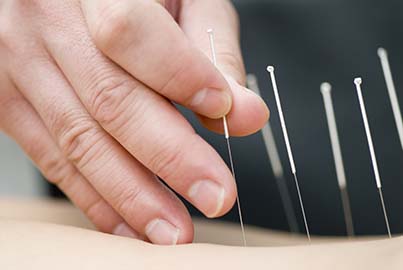Most people have heard of using Acupuncture as a way to relief Chronic Pain. However, most people have never tried acupuncture, primarily due to this one, simple question: “Does it work?”

Does It Work?
Okay, that being said, “Does it work?” Or shall we ask “How does it work?” Acupuncture is the practice of using small needles inserted at very precise points on the body to promote natural healing and improve functioning. Acupuncture stimulates nerves, muscles and connective tissues, prompting increased blood flow to injured areas of the body, boosting the body’s natural healing process. Acupuncture provides a low risk treatment option that can be beneficial for pain syndromes due to an injury or associated with chronic degenerative diseases.
By creating a micro-wound in the affected area, the body’s healing powers are elicited. It is thought that the needles can stimulate trigger points—tender spots in the muscles that when manipulated provide relief. Testing acupuncture’s efficacy has proven difficult for Western science, and the results of clinical trials are often inconclusive. Skeptics of alternative medicine see this as proof that acupuncture is no more than a sophisticated placebo effect, but others point out that the clinical trial method of study may simply be inadequate for evaluating acupuncture. Whatever the case, enough studies were done with positive results for the National Institute of Health to deem it an acceptable treatment for certain pain conditions and chemotherapy related nausea in 1997, and insurance plans increasingly cover it, especially when used as an adjunctive therapy along with conventional care.
So Again, Does It Work?
In traditional Chinese medicine, acupuncture is linked to the belief that disease is caused by disruptions to the flow of energy, or qi, in the body. One major hypothesis is that acupuncture works through neurohormonal pathways. Basically, you put the needle through specific points in the body and stimulate the nerve. In this respect, especially if you’re suffering from chronic pain, opening up the flow of energy in your body can always be a good thing.
Resources: Cheng, Xinnong, and Liangyue Deng. Chinese Acupuncture and Moxibustion. Rev. ed. Beijing: Foreign Language Press, 1999. Reston, James. (1971, July 26). “Now, About My Operation in Peking.” The New York Times. Page 1. And Live Science – “What is Acupuncture” by Elizabeth Palermo, Assoc. Ed. (2017, June 21).
Contact Michigan Pain Consultants Today
Exciting medical breakthroughs occur each day and continue to keep Michigan Pain Consultants at the forefront of providing effective pain management programs in the West Michigan area.
Make an appointment for a new patient consultation with one of their board-certified pain physicians. All of Michigan Pain Consultant’s physicians are Board Certified in Anesthesiology or Physical Medicine & Rehabilitation and have advanced training and experience in Pain Medicine. You can begin first by visiting online at MyLifeBeyondPain.com, MichiganPain.com, or by calling them at (800)281-3237.
With six locations throughout West Michigan, Michigan Pain Consultants comprehensive interdisciplinary approach to pain care offers patients and providers renewed hope for relief from chronic pain. Chronic pain should be treated like other chronic medical conditions such as diabetes, asthma, or congestive heart failure. Chronic pain requires chronic treatment. The goal of the treatment is to optimize the management of the pain, as opposed to curing the pain.
